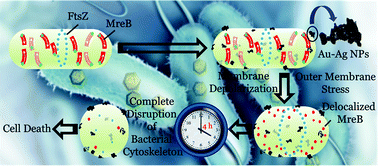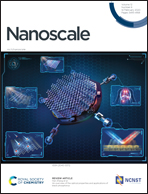Bimetallic gold–silver nanoparticles mediate bacterial killing by disrupting the actin cytoskeleton MreB†
Abstract
The actin cytoskeleton is required for the maintenance of the cell shape and viability of bacteria. It remains unknown to which extent nanoparticles (NPs) can orchestrate the mechanical instability by disrupting the cytoskeletal network in bacterial cells. Our work demonstrates that Au–Ag NPs disrupt the bacterial actin cytoskeleton specifically, fluidize the inner membrane and lead to killing of bacterial cells. In this study, we have tried to emphasize on the key parameters important for NP–cell interactions and found that the shape, specific elemental surface localization and enhanced electrostatic interaction developed due to the acquired partial positive charge by silver atoms in the aggregated NPs are some of the major factors contributing towards better NP interactions and subsequent cell death. In vivo studies in bacterial cells showed that the NPs exerted a mild perturbation of the membrane potential. However, its most striking effect was on the actin cytoskeleton MreB resulting in morphological changes in the bacterial cell shape from rods to predominantly spheres. Exposure to NPs resulted in the delocalization of MreB patches from the membrane but not the tubulin homologue FtsZ. Concomitant with the redistribution of MreB localization, a dramatic increase of membrane fluid regions was observed. Our studies reveal for the first time that Au–Ag NPs can mediate bacterial killing and disrupt the actin cytoskeletal functions in bacteria.



 Please wait while we load your content...
Please wait while we load your content...